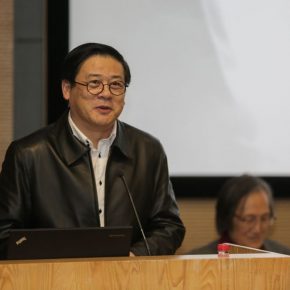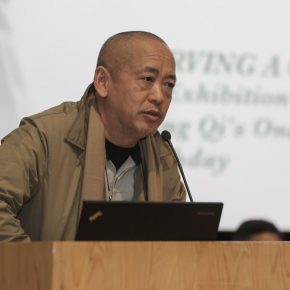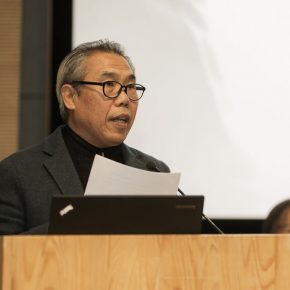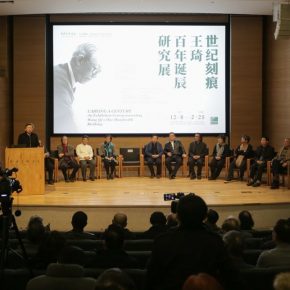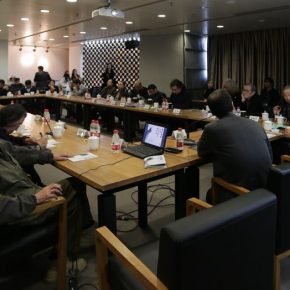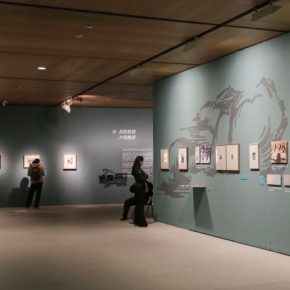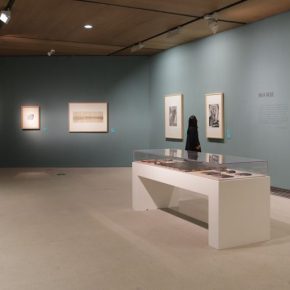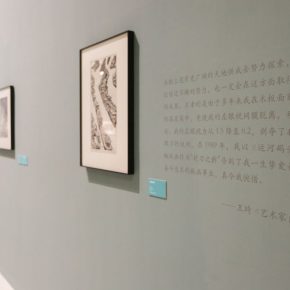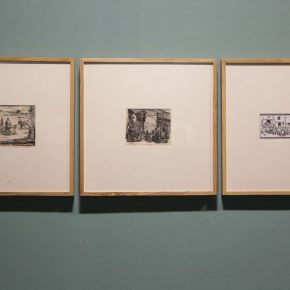
Speaking of Wang Qi, people might first think of his creation of woodcut prints that started during the War of Resistance against Japan. He started from the “anti-invasion struggle” before the founding of the People’s Republic of China to the “worker-peasant construction” and “urban social change” after the founding of the People’s Republic of China, Wang Qi’s prints both clearly reflect the themes & styles of different times, and the development process from woodcut to printmaking. However, based on the panoramic view of the development of Chinese art, Wang Qi’s achievements and contributions were not confined to the field of printmaking, but embodied in the aspects of creation, research, education and organization of events. As the preface of the exhibition states, Wang’s comprehensive achievements and contributions were brought together to form an encyclopedia of Chinese art over one hundred years, which has enriched the general understanding of Chinese art in the 20th century. It is entitled “Carving a Century”, which does not only refer to the scratches that remain as made by a knife, and the imprint that remains by Wang Qi’s art activities in the development of Chinese art.
On December 8, 2017, in order to fully understand and sort out the contributions made by Wang Qi to Chinese art in his century-long artistic life, “Carving a Century: An Exhibition Commemorating Wang Qi’s 100th Birthday”, hosted by CAFA, and co-organized by CAFA Art Museum, Department of Printmaking of the School of Plastic Arts, and the School of Humanities, opened at CAFA Art Museum. It was curated by Guo Hongmei and Song Jinming, divided into four parts including “Revolutionary Art of the Youth in Wartime”, “Teaching in the Academy for 30 Years using Brush and Knife”, “New Appearances of Wood, and Urban Symphony”, and “The Use of Colored Ink to Express the Self in Old Age”, to feature a total of more than 140 works of art created by Wang Qi showing all the stages, including prints, sketches, colored ink paintings, calligraphy and so on. The exhibition also sifts through dozens of literature collected by Wang Qi’s family members, the archive rooms of CAFA, Wang Qi Art Museum, etc., striving to present Wang Qi’s comprehensive achievements in artistic creation, theory and teaching in an intuitive way. Coincided with the 100th anniversary?of CAFA and Wang Qi’s 100th birthday, it is also part of CAFA “Hundred Years of Glory” series of events.
Fan Di’an, President of CAFA, addressed the opening ceremony, and recalled Wang Qi's outstanding contributions to Chinese art and CAFA. Xu Li, Party Secretary of China Artists Association, Vice Chairman and Secretary-General, and Wang Huaxiang, Director of the Department of Printmaking of the School of Plastic Arts, CAFA, who was a representative of the students of Wang Qi, respectively addressed the opening ceremony.
The four parts of the exhibition present the artistic history of Wang Qi, and the woodcut creations that started his artistic career in 1937. Wang Qi’s early printmaking was a fusion and digestion of the inheritance of the national tradition and absorption of the artistic style of the Soviet Union’s realism, which gradually formed his artistic style and appearance, combining rough outlines with thin lines to form intermediate colors. Early on he created a large number of woodcuts themed on the hardship of poor people, exposing the darkness of old society, to express the hatred of the enemy. After the founding of New China, Wang Qi’s woodcut art entered a new phase. The exhibition presents us with three topics, including the “Worker-Peasant Construction”, “Amorous Feelings of Forest” and “Realistic Concerns”. It used different ways of expression to express different contents in woodcuts, creating different artistic concepts with different tastes and expressions, enriching a fantastic situation that Chinese people enthusiastically participated in the social construction. Entering the 1980s, Wang Qi’s printmaking art had a new breakthrough, focusing on the themes of “urban landscape” and “old trees”, urban themes took tall buildings and criss-cross roads as the main body with black and white contrasting elements, with a bright rhythm, cheerful melodies, and themes that are rich in the beauty of modern order, the beauty of material and beauty of structure. Printmaking art constitutes the most important clue of Wang Qi’s artistic activities. Wang Qi finished a piece of “Canal Wharf” in 1989, which was the last piece of Wang’s printmaking creation over more than 50 years. It is also on display in this exhibition.
When he was engaged in the printmaking creation, Wang Qi was also actively involved in the writing and thinking of art theory. As early as the 1940s, he has served as Editor-in-Chief of Fine Arts at Chongqing’s “Xinhua Daily” and “National Gazette”, and Nanjing’s “New Min Pao”. After starting at CAFA, he worked in “Art Research” and “World Art” journals, and has also been the chief editor of “Fine Arts” magazine for a long time. In addition, he has also actively participated in the establishment of the Department of Art History, CAFA.
Discussions on the art form had been a hot topic in the field of art for a period of time, and Wang Qi issued an article entitled “Exploration of Art Forms” in 1979, and declared that the important difference between art and science lay in artists using visual means to reveal the face of life, and artists should be good at using various images of life to create vivid artistic images. Furthermore, it pointed out that the exploration of new forms aimed at profoundly expressing the ideological content, to more truly and completely representing the objective of an object. The innovation of art forms should be based on inheriting the tradition, while the exploring of new art forms relied on the level of mass appreciation. It was a systematic, objective and comprehensive essay on the art form after the “Cultural Revolution”, which has played a healthy role in promoting the exploration of the art form at that time. Wang Qi also actively promoted the systematic study of the works of the western art history, especially the Renaissance Italian art, 19th-century French realism and impressionism, and various modern schools of the 20th century, which are all embodied in his edited teaching material “European History of Art”. In addition, Wang Qi was also actively engaged in art organizations and cultural exchange activities. After the end of the printmaking creation, Wang Qi started to create Chinese painting and calligraphy from the 1990s.
It takes Wang Qi’s artistic creation, changes of style and theoretical studies as the framework, considering the structure of time, fully presenting the artistic experiences and accomplishments of Wang Qi, in order to build his carved traces of Chinese art in the 20th century. Wang Qi donated more than 120 printmaking works to his alma mater during his lifetime. On the occasion of this exhibition, Wang Wei, son of Wang Qi donated a total of 7 precious original woodcuts and other precious documents by Wang Qi to his alma mater on behalf of his family again. It has further enriched CAFAM’s collection of works by Wang Qi, and also enriches the historical sequence of the collection of modern Chinese prints collected by CAFAM. This exhibition remains on view till February 25, 2018.
Text by Zhang Wenzhi, translated by Chen Peihua and edited by Sue/CAFA ART INFO
Photo by Hu Sichen/CAFA ART INFO



